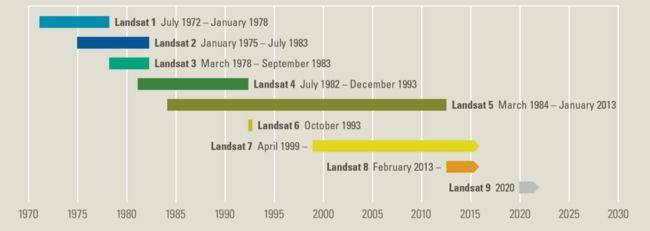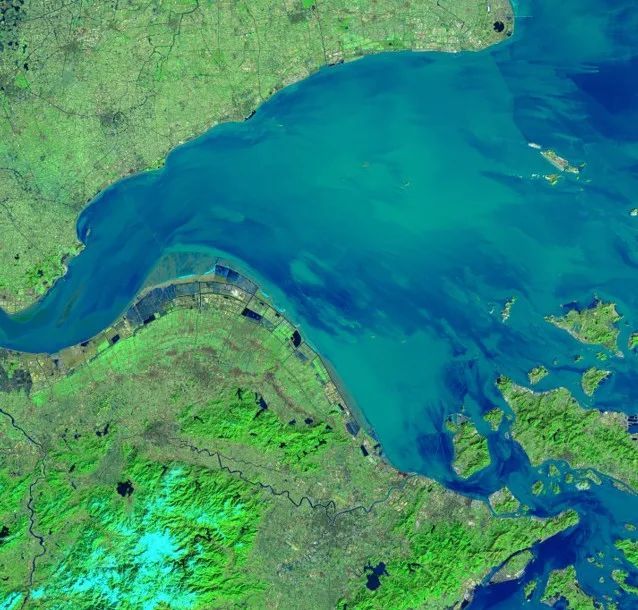Python干货 | 制作遥感影像图
0.前言
近50年来,Landsat系列卫星为我们提供了非常长时间序列的地球表面观测信息,现阶段Landsat卫星仍然在服役,为全球治理和科学研究提供了非常宝贵的数据。
图源:USGS
现在是大数据时代,作为地球科学领域来说,遥感资料是不折不扣的宝贵的一手实测资料,且数据量非常的庞大。现阶段来说,可能大部分遥感资料生产的速度远远大于我们去利用它的速度,所以大部分遥感资料还是处于沉睡状态,在等待着技术的继续革新,唤醒这沉睡的数据,使其发光发热。
今天我们来探索一下使用Landsat数据来制作一张遥感影像图。先上图!图示为杭州湾
东南形胜,三吴都会,钱塘自古繁华。
1.准备工作
先准备下载好的Landsat8数据集,Landsat8中包括11个波段,在数据文件夹中,每个波段一个tif文件,这个tif文件中包括了坐标信息、波段值等信息,可以通过Python的rasterio模块来读取(如果有需要的话,可以详细写一下使用这个库来读取tif文件信息)。
导入接下来要用到的Python库。
import numpy as np
import os
import matplotlib.pyplot as plt
import tifffile as tiff
from skimage import exposure使用遥感影像制作底图时,通常是选取三个波段的数据分别作为图像RGB的三个通道,其中RGB表示红绿蓝三个通道,不同波段组合将得到不同的效果。
我们使用比较多的Google earth 中就用到了Landsat数据,他的波段组合是432。即使用Landsat的B4、B3和B2三个波段作为影像的三个通道。
上图的杭州湾图使用的是753。
如果波段组合是432情况下的效果如下图所示,432波段合成的真彩色图片,比较接近地物真实色彩,图像平淡,色调偏暗。
2.动起手来
首先把Landsat各个波段的数据读取出来。用到了一丢丢Python小技能,参见:
8个你应该掌握的Python列表技能
7个你应该掌握的Python字典操作
l8path = r'pathOfLandsat8\LC08_L1TP_118039_20160126_20170330_01_T1'
fileName = l8path.split("\")[-1]
prefix = os.path.join(l8path,fileName)
bands = ['B1', 'B2', 'B3', 'B4', 'B5', 'B6', 'B7', 'B10', 'B11']
n_bands = len(bands)
temp = tiff.imread(prefix + "_B1.TIF")
arr = np.zeros((n_bands, np.shape(temp)[0], np.shape(temp)[1]), dtype=np.float)
for i in range(n_bands):
file2read = prefix + "_" + bands[i] + ".TIF"
arr[i, :, :] = tiff.imread(file2read)选取三个波段
rgb=(6, 4, 2) #Python下界为0,其实是753rgb_bands = arr[rgb, :, :]
rgb_bands = _stretch_im(rgb_bands, 2)
rgb_bands = bytescale(rgb_bands).transpose([1, 2, 0])
plt.close('all')
fig, ax = plt.subplots(figsize=figSize)
ax.imshow(rgb_bands, extent=extent)
ax.set_title(title)
ax.set(xticks=[], yticks=[])其中用到了两个函数,其中一个是提高图像的对比度,另外一个将波段数据归一化到像素点常用的[0,255]区间内。
def _stretch_im(arr, str_clip):
s_min = str_clip
s_max = 100 - str_clip
arr_rescaled = np.zeros_like(arr)
pLow, pHigh = np.percentile(arr[arr > 0], (s_min, s_max))
arr_rescaled = exposure.rescale_intensity(arr, in_range=(pLow, pHigh))
return arr_rescaled.copy()def bytescale(data, high=255, low=0, cmin=None, cmax=None):
if data.dtype == "uint8":
return data
if high > 255:
raise ValueError("high should be less than or equal to 255.")
if low < 0:
raise ValueError("low should be greater than or equal to 0.")
if high < low:
raise ValueError("high should be greater than or equal to low.")
if cmin is None or (cmin < data.min()):
cmin = float(data.min())
if (cmax is None) or (cmax > data.max()):
cmax = float(data.max())
# Calculate range of values
crange = cmax - cmin
if crange < 0:
raise ValueError("cmax should be larger than cmin.")
elif crange == 0:
raise ValueError(
"cmax and cmin should not be the same value. Please specify "
"cmax > cmin"
)
scale = float(high - low) / crange
# If cmax is less than the data max, then this scale parameter will create
# data > 1.0. clip the data to cmax first.
data[data > cmax] = cmax
bytedata = (data - cmin) * scale + low
return (bytedata.clip(low, high) + 0.5).astype("uint8")3.小结
大功告成!
这个遥感影像图,可以作为我们出图的底图,还可以实现两张遥感影像图的融合,在影像图上叠加自己想要叠加的数据,欲知详情,且听下回分解....
因遥感数据较大,关注公众号 海洋纪 ,后台回复 Landsat 获取数据及源码。
Tips:不同波段组合情况可以实现不同的效果,大家可以自己试试看。如543,652,765等。
最后,感谢阅读。


